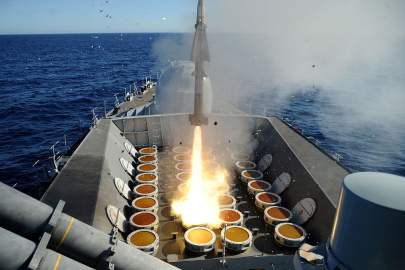Partners and Progress on Missile Defense By Alan W. Dowd, ASCF Senior Fellow

Part one of this series focusing on the urgent need for missile defense discussed the numerous threats posed by enemy regimes and rogue states arming with missiles and kamikaze drones. In this issue, we will look at how America and its allies are responding to this threat.
A System of Systems
The good news amidst all of the terrifying news discussed in the previous issue is that the U.S. and it's allies have made progress—albeit far too slowly—building a layered, networked system of systems to defend against missile attack.
Some 20 countries, plus the NATO alliance, are part of what might be called an international missile defense (IMD) coalition.
Japan hosts IMD radars, Aegis missile-defense ships and Patriot systems. Britain and Denmark are key partners on early-warning IMD radars. Poland and Romania are deploying Aegis Ashore anti-missile batteries. Saudi Arabia and Qatar deploy Patriot systems. South Korea hosts Patriot systems and a THAAD battery. The UAE hosts two THAAD batteries and Patriot systems. In addition, the mobile THAAD system has been deployed in Guam, Israel and Japan, and the U.S. and Saudi Arabia have agreed on another THAAD deal.
Israel and the U.S. have collaborated to field the Arrow anti-missile system, David's Sling system and Iron Dome system in Israel. The U.S. and Israel recently agreed to allow Germany to purchase the Arrow-3 system. The U.S. Army is integrating Iron Dome interceptors into Army air defenses. And the U.S. recently stood up its first military base on Israeli soil—a facility expressly for “operating a missile-defense system,” as Real Clear Defense reports.
There are missile-defense radars in Alaska, Hawaii, California, Massachusetts, Greenland, Britain, Turkey, Israel and Japan; missile-defense data centers in New York; anti-missile interceptors in Alaska and California; an armada of Aegis missile-defense ships at sea; scores of Patriot, Aegis Ashore and THAAD systems on land; and supporting satellites and sensors orbiting in space. Plus, the Missile Defense Agency (MDA) plans to build an integrated missile-defense command and control center on Guam.
This system of systems has an impressive record in testing. The MDA reports that 92 of 112 intercept attempts have been successful across the various missile-defense systems deployed by the U.S. That’s an 82-percent success rate. The Ground-based Midcourse Defense (GMD) system has scored 12 successful intercepts in 19 tests. The Aegis system has 44 intercepts in 55 tests. (Just last month, Japanese Aegis-equipped warships conducted successful intercepts of simulated ballistic missiles.) THAAD has a perfect 16 intercepts out of 16 tests.
While it would be unwise to deploy a Potemkin missile defense, it would be irresponsible to delay deployment until the system can guarantee 100-percent success—a standard that’s impossible and so high that “failure” is inevitable. As the missile threat metastasizes, we must not allow perfection to be the enemy of the possible. The question critics of missile defense must answer is this: If an American or allied city is in the path of a PRC, Russian, Iranian, North Korean, terrorist or accidentally-launched missile, would they prefer an 82-percent chance or even a 50-50 chance of intercepting the killer rocket, or a zero-percent chance—something guaranteed by not fully funding and not deploying a missile shield?
Battle Tested
What’s too often overlooked is that missile defense has been put to the test where it matters most: in the real-world battlespace.
In 2003, in the early stages of the Iraq War, U.S. missile-defense assets intercepted nine inbound Iraqi missiles, shielding the coalition’s headquarters in Kuwait from a decapitation strike. In 2014, Israel’s Iron Dome rocket-defense system—relying on the same principles as longer-range missile defenses—intercepted 735 inbound threats and registered a kill rate of nearly 90 percent. In 2016, Saudi Patriot missile-defense batteries knocked down missiles fired by Iranian-backed rebels based in Yemen. (Saudi Arabia’s U.S.-supplied Patriot anti-missile systems have intercepted 90 percent of Iranian-supplied missiles and drones launched from Yemen.) Also in 2016, Aegis missile defenses detected and destroyed an inbound cruise missile fired at the USS Mason operating of the coast of Yemen. In 2017, Israel’s Arrow anti-missile system tallied its first real-world intercept, hitting an inbound threat from Syria. Israel’s Iron Dome system has a 97-percent intercept rate in engagements with rockets launched from Palestinian territory in 2021 and 2022. And in 2022, the UAE used its U.S.-built THAAD anti-missile system on two separate occasions to intercept ballistic missiles, cruise missiles and drones launched by Houthi militants. The Houthis were targeting oil facilities not far from Al-Dhafra Air Base, where U.S. forces are deployed. It was the THAAD system’s first confirmed use in a military operation.
In addition, Ukraine has shot down 222 of 330 Iranian-made suicide drones launched by Russia, according to the Wall Street Journal, along with scores of Russian missiles. Defense analyst Sebastien Roblin reports that Ukraine has used a mix antiaircraft cannons, heavy machine guns, man-portable air defense missiles (including U.S. Stingers and British Starstreaks), and Russian-built Osa, Buk and S-300 antiaircraft and anti-missile systems to knock out Russia’s kamikaze drones and missiles. Kiev is now taking delivery of U.S.-built NASAMS and German-built Iris-T systems, which will enhance Ukraine’s missile defenses.
To be sure, missile defenses should not and cannot be the only means of trying to protect people of goodwill from this metastasizing threat. Treaty enforcement, nonproliferation regimes, deterrence, left-of-launch strategies, hardening of vulnerabilities, counter-proliferation capabilities, and cyber-weapons and other non-kinetic tools must be brought to bear as well. However, since treaties are only as good as the character of the governments that sign them, since irrational regimes may be immune from deterrence, since counterproliferation via preemptive military action is a high-risk proposition (as America learned in Iraq), and since counterproliferation via third parties leaves much to chance and mischief (as America learned in Syria), robust missile defenses must be part of the answer to the missile threat.
Like an insurance policy for home or health, nations need to invest in missile defense in order to prepare for—and survive—the worst. Regrettably, America is not investing enough in its missile-defense insurance policy. Americans have spent some of $227 billion on missile defense since 1985. That may sound like a lot of money. But when spread over 38 years, missile defense has cost $5.9 billion annually. In comparison to safety-net programs, the Pentagon’s budget or the overall federal budget, the amount invested annually in missile defense is literally a rounding error.
Imperative
The technology is finally catching up to President Ronald Reagan’s vision. “It seems to me much more practical if you could find something that kills weapons instead of kills people,” Reagan observed with his trademark matter-of-fact wisdom. “Wouldn't it make a lot more sense if we could find—as there has been in history for every weapon—a defensive weapon? We're researching for something that could make it…virtually impossible for these missiles to reach their targets. And if we find such a thing, my proposal is that we make it available to all the world.”
And just as the technology catches up to Reagan’s farsighted vision, the world’s most terrifying regimes—regimes that boast about erasing their neighbors, regimes that want to upend the liberal international order, regimes that believe there is no God to hold them to account, regimes that believe they are acting on God’s behalf—are catching up in the race for missilery and nuclear weaponry.
Add it all up, and missile defenses are no longer a distant theoretical possibility, or a costly luxury, or a bargaining chip at the summit table. They are a moral imperative.











